Effects of Microplastics on Selected Earthworm Species
Abstract
:1. Introduction
2. Materials and Methods
2.1. MP Preparation for Experimentation
2.2. Experiment Design and Settings
2.3. Biotic Response of Earthworms to MPs
2.4. Data Analysis
3. Results
3.1. Effect of Microplastics on Glutathione S-Transferase
3.2. Effect of Microplastics on Respiration
3.3. Effects on Individual Survival
3.4. Effects of Microplastics on Bacterial Flora
4. Discussion
4.1. Biotic Response of Earthworms to MPs
4.2. Ecological Effects
4.3. Microplastic Parameters and Pollution at Terrestrial Sites
5. Conclusions
Author Contributions
Funding
Institutional Review Board Statement
Informed Consent Statement
Data Availability Statement
Conflicts of Interest
References
- Briones, M.J.I.; Moran, P.; Posada, D. Are the sexual, somatic and genetic characters enough to solve nomenclatural problems in lumbricid taxonomy? Soil Biol. Biochem. 2009, 41, 2257–2271. [Google Scholar] [CrossRef]
- Csuzdi, C.; Zicsi, A. Earthworms of Hungary (Annelida: Oligochaeta, Lumbricidae); Hungarian Natural History Museum: Budapest, Hungary, 2003; p. 271. [Google Scholar]
- Adhikari, K.; Astner, A.F.; DeBruyn, J.M.; Yu, Y.; Hayes, D.G.; O’Callahan, B.T.; Flury, M. Earthworms Exposed to Polyethylene and Biodegradable Microplastics in Soil: Microplastic Characterization and Microbial Community Analysis. ACS Agric. Sci. Technol. 2023, 3, 340–349. [Google Scholar] [CrossRef]
- Song, J.; Chen, X.; Li, S.; Tang, H.; Dong, S.; Wang, M.; Xu, H. The environmental impact of mask-derived microplastics on soil ecosystems. Sci. Total Environ. 2024, 912, 169182. [Google Scholar] [CrossRef] [PubMed]
- Suleiman, H.; Rorat, A.; Grobelak, A.; Grosser, A.; Milczarek, M.; Płytycz, B.; Kacprzak, M.; Vandenbulcke, F. Determination of the performance of vermicomposting process applied to sewage sludge by monitoring of the compost quality and immune responses in three earthworm species: Eisenia fetida, Eisenia andrei and Dendrobaena veneta. Bioresour. Technol. 2017, 241, 103–112. [Google Scholar] [CrossRef]
- Cole, M.; Lindeque, P.; Halsband, C.; Galloway, T.S. Microplastics as contaminants in the marine environment: A review. Mar. Pollut. Bull. 2011, 62, 2588–2597. [Google Scholar] [CrossRef]
- Ivar do Sul, J.A.; Costa, M.F. The present and future of microplastic pollution in the marine environment. Environ. Pollut. 2014, 185, 352–364. [Google Scholar] [CrossRef]
- Zubris, K.A.V.; Richards, B.K. Synthetic fibers as an indicator of land application of sludge. Environ. Pollut. 2005, 138, 201–211. [Google Scholar] [CrossRef]
- Barceló, D. Microplastics in the environment: Analytical chemistry methods, sorption materials, risks and sustainable solutions. Anal. Bioanal. Chem. 2024, 416, 3479–3485. [Google Scholar] [CrossRef] [PubMed]
- de Souza Machado, A.A.; Lau, C.W.; Till, J.; Kloas, W.; Lehmann, A.; Becker, R.; Rillig, M.C. Impacts of microplastics on the soil biophysical environment. Environ. Sci. Technol. 2018, 52, 9656–9665. [Google Scholar] [CrossRef]
- Lear, G.; Kingsbury, J.M.; Franchini, S.; Gambarini, V.; Maday, S.D.M.; Wallbank, J.A.; Weaver, L.; Pantos, O. Plastics and the microbiome: Impacts and solutions. Environ. Microbiome 2021, 16, 2. [Google Scholar] [CrossRef]
- Kallenbach, E.M.; Rødland, E.S.; Buenaventura, N.T.; Hurley, R. Microplastics in terrestrial and freshwater environments. In Microplastic in the Environment: Pattern and Process; Springer Nature: Berlin/Heidelberg, Germany, 2022; pp. 87–130. [Google Scholar]
- Liu, Y.; Xu, G.; Yu, Y. Effects of polystyrene microplastics on accumulation of pyrene by earthworms. Chemosphere 2022, 296, 134059. [Google Scholar] [CrossRef] [PubMed]
- Thompson, R.C.; Moore, C.J.; vom Saal, F.S.; Swan, S.H. Plastics, the environment and human health: Current consensus and future trends. Philos. Trans. R. Soc. B 2009, 364, 2153–2166. [Google Scholar] [CrossRef] [PubMed]
- Wang, J.; Coffin, S.; Sun, C.; Schlenk, D.; Gan, J. Negligible Effects of Microplastics on Animal Fitness and HOC Bioaccumulation in Earthworm Eisenia Fetida in Soil. Environ. Pollut. 2019, 249, 776–784. [Google Scholar] [CrossRef]
- Lwanga, E.H.; Gertsen, H.; Gooren, H.; Peters, P.; Salánki, T.; van der Ploeg, M.; Besseling, E.; Koelmans, A.A.; Geissen, V. Incorporation of microplastics from litter into burrows of Lumbricus terrestris. Environ. Pollut. 2017, 220, 523–531. [Google Scholar] [CrossRef]
- Trakić, T.; Popović, F.; Sekulić, J.; Hackenberger, D.K. Ecotoxicological Effects of Commercial Microplastics on Earthworm Eisenia fetida (Savigny, 1826) (Clitellata; Lumbricidae). Agriculture 2024, 14, 267. [Google Scholar] [CrossRef]
- Rodríguez-Seijo, A.; da Costa, J.P.; Rocha-Santos, T.; Duarte, A.C.; Pereira, R. Oxidative stress, energy metabolism and molecular responses of earthworms (Eisenia fetida) exposed to low-density polyethylene microplastics. Environ. Sci. Pollut. Res. 2018, 25, 33599–33610. [Google Scholar] [CrossRef] [PubMed]
- Habig, W.H.; Pabst, M.J.; Fleischner, G.; Gatmaitan, Z.; Arias, I.M.; Jakoby, W.B. The Identity of Glutathione S-Transferase B with Ligandin, a Major Binding Protein of Liver. Proc. Natl. Acad. Sci. USA 1974, 71, 3879–3882. [Google Scholar] [CrossRef]
- Hugo, A. Catalase in vitro. In Methods in Enzymology; Academic Press: Cambridge, MA, USA, 1984; Volume 105, pp. 121–126. ISBN 9780121820053. [Google Scholar]
- Marion, B. A rapid and sensitive method for the quantitation of microgram quantities of protein utilizing the principle of protein-dye binding. Anal. Biochem. 1976, 72, 248–254. [Google Scholar]
- Kostecka, J.; Garczyńska, M.; Pączka, G.; Mazur-Pączka, A. Chemical composition of earthworm (Eisenia fetida Sav.) biomass and selected determinants for its production. J. Ecol. Eng. 2022, 23. [Google Scholar] [CrossRef]
- Kowald, G.R.; Stürzenbaum, S.R.; Blindauer, C.A. Earthworm Lumbricus rubellus MT-2: Metal Binding and Protein Folding of a True Cadmium-MT. Int. J. Mol. Sci. 2016, 17, 65. [Google Scholar] [CrossRef]
- Dominguez, J.; Gomez-Brandon, M. The influence of earthworms on nutrient dynamics during the process of vermicomposting. Waste Manag. Res. 2013, 31, 859–868. [Google Scholar] [CrossRef] [PubMed]
- Stürzenbaum, S.R.; Kille, P.; Morgan, A.J. The identification, cloning and characterization of earthworm metallothionein. FEBS Lett. 1998, 431, 437–442. [Google Scholar] [CrossRef] [PubMed]
- Khalid, N.; Aqeel, M.; Noman, A. Microplastics could be a threat to plants in terrestrial systems directly or indirectly. Environ. Pollut. 2020, 267, 115653. [Google Scholar] [CrossRef]
- Huang, Y.; Liu, Q.; Jia, W.; Yan, C.; Wang, J. Agricultural plastic mulching as a source of microplastics in the terrestrial environment. Environ. Pollut. 2020, 260, 114096. [Google Scholar] [CrossRef]
- Jiang, X.; Chang, Y.; Zhang, T.; Qiao, Y.; Klobučar, G.; Li, M. Toxicological effects of polystyrene microplastics on earthworm (Eisenia fetida). Environ. Pollut. 2020, 259, 113896. [Google Scholar] [CrossRef] [PubMed]
- Cheng, Y.; Zhu, L.; Song, W.; Jiang, C.; Li, B.; Du, Z.; Wang, J.; Wang, J.; Li, D.; Zhang, K. Combined effects of mulch film-derived microplastics and atrazine on oxidative stress and gene expression in earthworm (Eisenia fetida). Sci. Total Environ. 2020, 746, 141280. [Google Scholar] [CrossRef]
- Kadac-Czapska, K.; Ośko, J.; Knez, E.; Grembecka, M. Microplastics and Oxidative Stress—Current Problems and Prospects. Antioxidants 2024, 13, 579. [Google Scholar] [CrossRef]
- Baloš, M.; Petrović, A.; Tubić, A.; Zeremski, T.; Gvozdenac, S.; Supić, D.; Bursić, V. Effects of Polyethylene Microplastics in Agricultural Soil on Eisenia fetida (Annelida: Oligochaeta) Behavior, Biomass, and Mortality. Agriculture 2024, 14, 578. [Google Scholar] [CrossRef]
- Lackmann, C.; Velki, M.; Šimić, A.; Müller, A.; Braun, U.; Ečimović, S.; Hollert, H. Two types of microplastics (polystyrene-HBCD and car tire abrasion) affect oxidative stress-related biomarkers in earthworm Eisenia andrei in a time-dependent manner. Environ. Int. 2022, 163, 107190. [Google Scholar] [CrossRef]
- Baeza, C.; Cifuentes, C.; Gonzalez, P.; Araneda, A.; Barra, R. Experimental exposure of Lumbricus terrestristo microplastics. Water Air Soil Poll. 2020, 231, 308. [Google Scholar] [CrossRef]
- Huerta Lwanga, E.; Gertsen, H.; Gooren, H.; Peters, P.; Salánki, T.; Van Der Ploeg, M.; Besseling, E.; Koelmans, A.A.; Geissen, V. Microplastics in the Terrestrial Ecosystem: Implications for Lumbricus terrestris (Oligochaeta, Lumbricidae). Environ. Sci. Technol. 2016, 50, 2685–2691. [Google Scholar] [CrossRef]
- Dabrowska, A. Soil microplastics—Current research trends and challenges: Preliminary results of the earthworm Eisenia fetida impact on glitters. Acta Hort. Regiotec. 2022, 25, 141–150. [Google Scholar] [CrossRef]
- Klimasz, M.; Grobelak, A. Accumulation of Spherical Microplastics in Earthworms Tissues-Mapping Using Raman Microscopy. Appl. Sci. 2024, 14, 10117. [Google Scholar] [CrossRef]
- Luyts, K.; Napierska, D.; Nemery, B.; Hoet, P.H.M. How physico-chemical characteristics of nanoparticles cause their toxicity: Complex and unresolved interrelations. Environ. Sci. Process. Impacts 2012, 15, 23–38. [Google Scholar] [CrossRef]
- Yang, Y.; Xu, G.; Yu, Y. Microplastics impact the accumulation of metals in earthworms by changing the gut bacterial communities. Sci. Total Environ. 2022, 831, 154848. [Google Scholar] [CrossRef]
- Zaller, J.G.; Saxler, N. Selective vertical seed transport by earthworms: Implications for the diversity of grassland ecosystems. Eur. J. Soil Biol. 2007, 43, S86–S91. [Google Scholar] [CrossRef]
- Cao, D.; Wang, X.; Luo, X.; Liu, G.; Zheng, H. Effects of Polystyrene Microplastics on the Fitness of Earthworms in an Agricultural Soil. IOP Conf. Ser. Earth Environ. Sci. 2017, 61, 012148. [Google Scholar] [CrossRef]
- Zhang, L.; Sintim, H.Y.; Bary, A.I.; Hayes, D.G.; Wadsworth, L.C.; Anunciado, M.B.; Flury, M. Interaction of Lumbricus Terrestris with Macroscopic Polyethylene and Biodegradable Plastic Mulch. Sci. Total Environ. 2018, 635, 1600–1608. [Google Scholar] [CrossRef]
- Li, W.; Zu, B.; Li, L.; Li, J.; Li, J.; Mei, X. Desorption of bisphenol A from microplastics under simulated gastrointestinal conditions. Front. Mar. Sci. 2023, 10, 1195964. [Google Scholar] [CrossRef]
- Judy, J.D.; Williams, M.; Gregg, A.; Oliver, D.; Kumar, A.; Kookana, R.; Kirby, J.K. Microplastics in municipal mixed-waste organic outputs induce minimal short to long-term toxicity in key terrestrial biota. Env. Pollut. 2019, 252, 522–531. [Google Scholar] [CrossRef] [PubMed]
- Kwak, J.I.; An, Y.J. Microplastic digestion generates fragmented nanoplastics in soils and damages earthworm spermatogenesis and coelomocyte viability. J. Hazard. Mater. 2021, 402, 124034. [Google Scholar] [CrossRef]
- Schell, T.; Rico, A.; Vighi, M. Occurrence, fate and fluxes of plastics and microplastics in terrestrial and freshwater ecosystems. Rev. Environ. Contam. Toxicol. 2020, 250, 1–43. [Google Scholar]
- Taurozzi, D.; Gallitelli, L.; Cesarini, G.; Romano, S.; Orsini, M.; Scalici, M. Passive biomonitoring of airborne microplastics using lichens: A comparison between urban, natural and protected environments. Environ. Int. 2024, 187, 108707. [Google Scholar] [CrossRef]

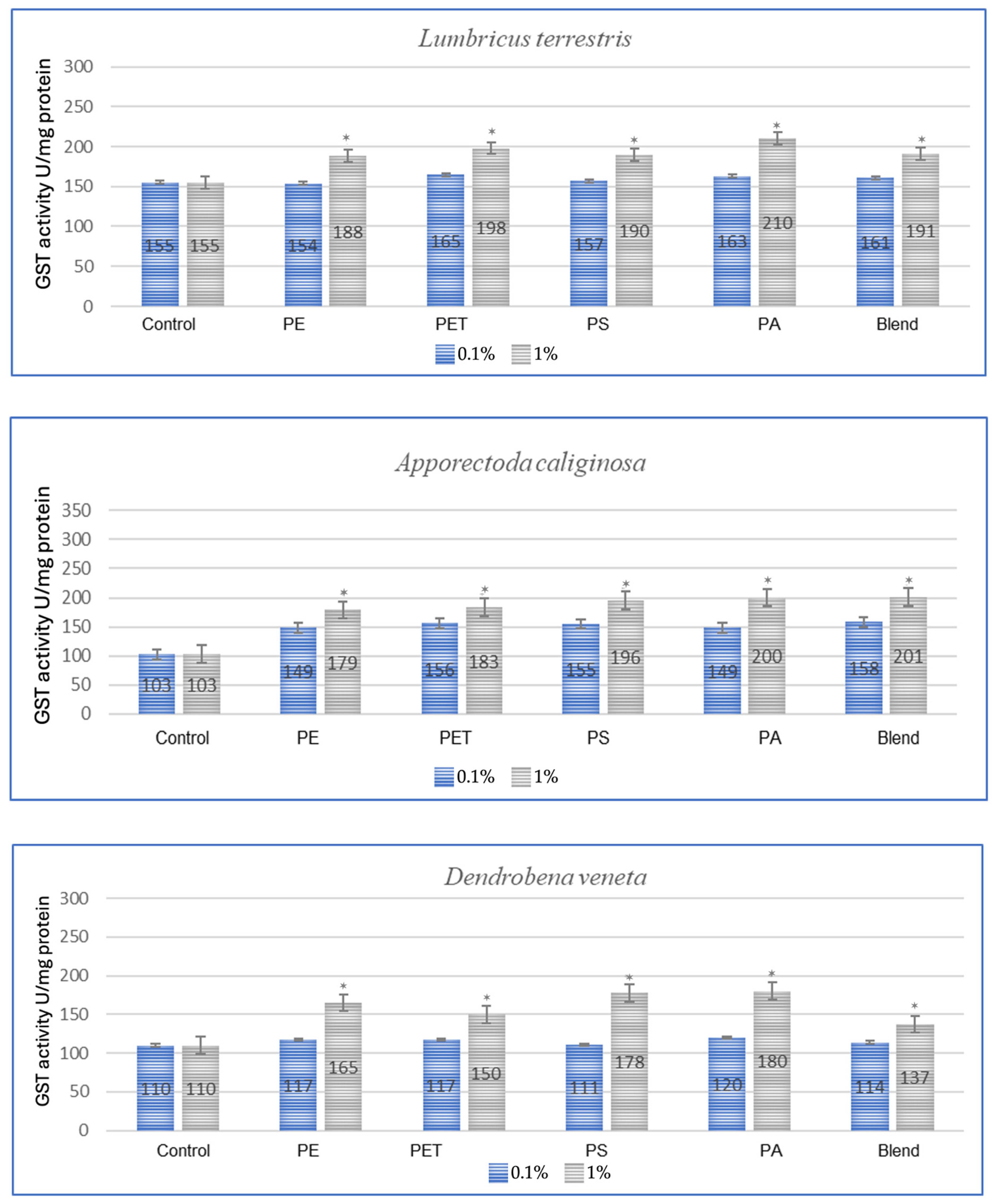




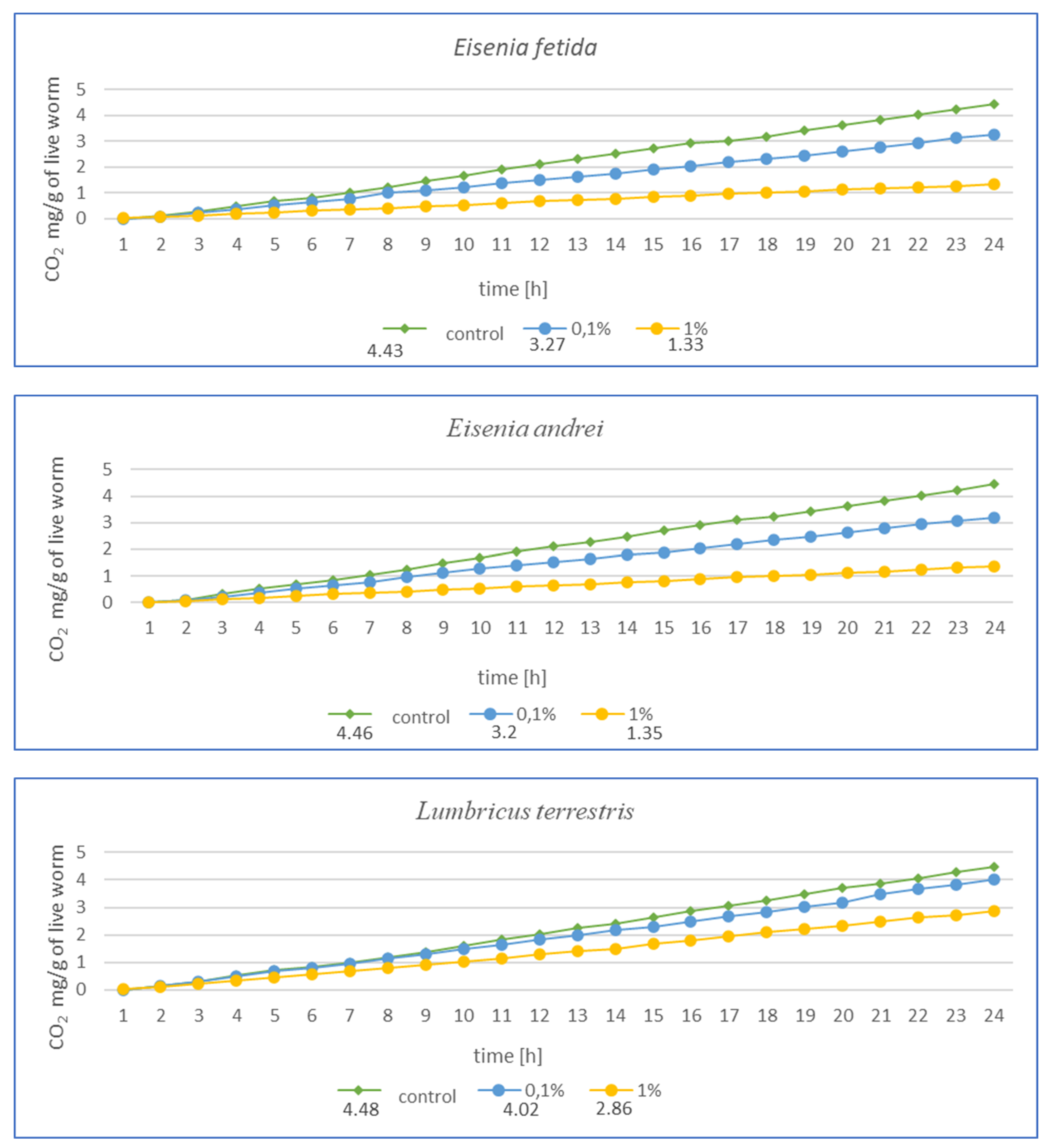



| Species | Concentration (w/v%) | 1 Month | 3 Months |
|---|---|---|---|
| E. andrei | 0.1% 1% | −19.56% −38.69% | −28.25% −69.73% |
| E. fetida | 0.1% 1% | −22.58% −40.13% | −26.18% −69.97% |
| A. caliginosa | 0.1% 1% | −37.60% −57.54% | −46.00% −60.32% |
| L. terrestris | 0.1% 1% | no changes −28.57% | −10.26% −36.16% |
| D. veneta | 0.1% 1% | −13.47% −37.82% | −12.88% −61.59% |
| Control | 1 Month 0.1% | 3 Months 1% | |
|---|---|---|---|
| E. fetida | 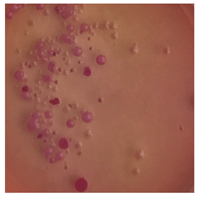 |  |  |
| E. andrei |  |  |  |
| A. caliginosa |  |  | 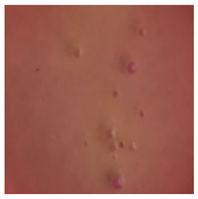 |
| D. veneta | 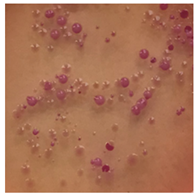 | 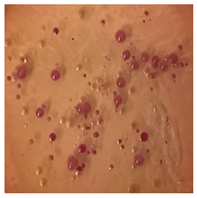 | 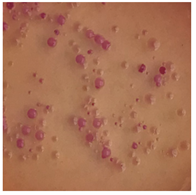 |
| L. terrestris |  |  |  |
| Control | 1 Month 0.1% | 3 Months 1% | |
|---|---|---|---|
| E. fetida | 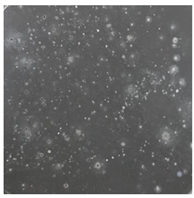 | 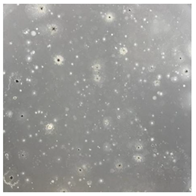 |  |
| E. andrei |  | 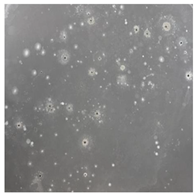 |  |
| A. caliginosa | 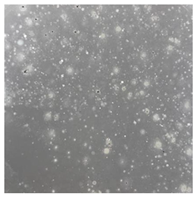 | 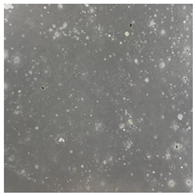 | 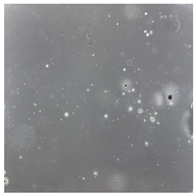 |
| D. veneta |  |  |  |
| L. terrestris | 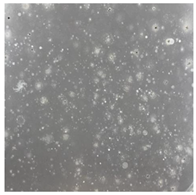 |  | 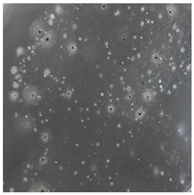 |
Disclaimer/Publisher’s Note: The statements, opinions and data contained in all publications are solely those of the individual author(s) and contributor(s) and not of MDPI and/or the editor(s). MDPI and/or the editor(s) disclaim responsibility for any injury to people or property resulting from any ideas, methods, instructions or products referred to in the content. |
© 2025 by the authors. Licensee MDPI, Basel, Switzerland. This article is an open access article distributed under the terms and conditions of the Creative Commons Attribution (CC BY) license (https://creativecommons.org/licenses/by/4.0/).
Share and Cite
Klimasz, M.; Grobelak, A. Effects of Microplastics on Selected Earthworm Species. Toxics 2025, 13, 201. https://doi.org/10.3390/toxics13030201
Klimasz M, Grobelak A. Effects of Microplastics on Selected Earthworm Species. Toxics. 2025; 13(3):201. https://doi.org/10.3390/toxics13030201
Chicago/Turabian StyleKlimasz, Marek, and Anna Grobelak. 2025. "Effects of Microplastics on Selected Earthworm Species" Toxics 13, no. 3: 201. https://doi.org/10.3390/toxics13030201
APA StyleKlimasz, M., & Grobelak, A. (2025). Effects of Microplastics on Selected Earthworm Species. Toxics, 13(3), 201. https://doi.org/10.3390/toxics13030201







